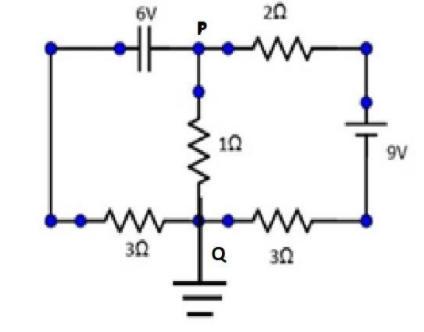
In the circuit shown the current in the $1\Omega $resistor is:

(A) 1.3A, from P to Q
(B) 0A
(C) 0.13A, from Q to P
(D) 0.13A, from P to Q
Answer
218.4k+ views
Hint: The question can be solved by grounding one end of the wire and then applying Kirchhoff’s Current Law to the loop formed. Kirchhoff’s Voltage Law can also be used to solve this problem.
Complete Step by Step Solution: Kirchhoff’s Current Law, deals with the conservation of charge entering and leaving a junction. Kirchhoff’s Current Law, often shortened to KCL, states that “The algebraic sum of all currents entering and exiting a node must equal zero.”
This law is used to describe how a charge enters and leaves a wire junction point or node on a wire.
Connect the lower wire of the $1\Omega $ resistor to the ground (Q end) and apply KCL. Consider the grounded circuit as shown below.

Applying, KCL at the Q point, we can write,
$\dfrac{{V + 6}}{3} + \dfrac{V}{1} = \dfrac{{9 - V}}{5}$
$ \Rightarrow V\left[ {\dfrac{1}{3} + \dfrac{1}{5} + 1} \right] = \dfrac{9}{5} - 2$
Simplifying the equation further,
$ \Rightarrow V\left[ {\dfrac{{5 + 3 + 15}}{{15}}} \right] = \dfrac{{9 - 10}}{5}$
The potential difference between points Q and P is given by,
$ \Rightarrow V = - \dfrac{1}{5} \times \dfrac{{15}}{{23}} = \dfrac{{ - 3}}{{23}} = - 0.13V$
Thus the current in the 1Ω resistor is ${\text{I = }}\dfrac{{\text{V}}}{{\text{R}}}{\text{ = }}\dfrac{{{\text{0}}{\text{.13}}}}{{\text{1}}}{\text{ = 0}}{\text{.13A}}$.
The current flows from Q to P. The correct answer is Option C.
Note: Kirchhoff's voltage law (KVL) states that the sum of all voltages around any closed loop in a circuit must be equal to zero. This is a consequence of charge conservation and also conservation of energy. This means that the sum of all potential differences across the component involved in the circuit gives a zero reading, as expected.
Assuming potential at Q is $V$, we apply KVL loop 1,
$9 - 2i - 1\left( {i - {i_1}} \right) - 3i = 0$.
When we apply KVL to loop 2,
$6 - 3{i_1} + 1\left( {i - {i_1}} \right) = 0$.
Solving the equations for the two loops,
${\text{i = 1}}{\text{.82A}}$ and ${{\text{i}}_{\text{1}}}{\text{ = 1}}{\text{.95A}}$.
Current through the $1\Omega $ resistor is ${\text{0}}{\text{.13A}}$.
Complete Step by Step Solution: Kirchhoff’s Current Law, deals with the conservation of charge entering and leaving a junction. Kirchhoff’s Current Law, often shortened to KCL, states that “The algebraic sum of all currents entering and exiting a node must equal zero.”
This law is used to describe how a charge enters and leaves a wire junction point or node on a wire.
Connect the lower wire of the $1\Omega $ resistor to the ground (Q end) and apply KCL. Consider the grounded circuit as shown below.

Applying, KCL at the Q point, we can write,
$\dfrac{{V + 6}}{3} + \dfrac{V}{1} = \dfrac{{9 - V}}{5}$
$ \Rightarrow V\left[ {\dfrac{1}{3} + \dfrac{1}{5} + 1} \right] = \dfrac{9}{5} - 2$
Simplifying the equation further,
$ \Rightarrow V\left[ {\dfrac{{5 + 3 + 15}}{{15}}} \right] = \dfrac{{9 - 10}}{5}$
The potential difference between points Q and P is given by,
$ \Rightarrow V = - \dfrac{1}{5} \times \dfrac{{15}}{{23}} = \dfrac{{ - 3}}{{23}} = - 0.13V$
Thus the current in the 1Ω resistor is ${\text{I = }}\dfrac{{\text{V}}}{{\text{R}}}{\text{ = }}\dfrac{{{\text{0}}{\text{.13}}}}{{\text{1}}}{\text{ = 0}}{\text{.13A}}$.
The current flows from Q to P. The correct answer is Option C.
Note: Kirchhoff's voltage law (KVL) states that the sum of all voltages around any closed loop in a circuit must be equal to zero. This is a consequence of charge conservation and also conservation of energy. This means that the sum of all potential differences across the component involved in the circuit gives a zero reading, as expected.
Assuming potential at Q is $V$, we apply KVL loop 1,
$9 - 2i - 1\left( {i - {i_1}} \right) - 3i = 0$.
When we apply KVL to loop 2,
$6 - 3{i_1} + 1\left( {i - {i_1}} \right) = 0$.
Solving the equations for the two loops,
${\text{i = 1}}{\text{.82A}}$ and ${{\text{i}}_{\text{1}}}{\text{ = 1}}{\text{.95A}}$.
Current through the $1\Omega $ resistor is ${\text{0}}{\text{.13A}}$.
Recently Updated Pages
Two discs which are rotating about their respective class 11 physics JEE_Main

A ladder rests against a frictionless vertical wall class 11 physics JEE_Main

Two simple pendulums of lengths 1 m and 16 m respectively class 11 physics JEE_Main

The slopes of isothermal and adiabatic curves are related class 11 physics JEE_Main

A trolly falling freely on an inclined plane as shown class 11 physics JEE_Main

The masses M1 and M2M2 M1 are released from rest Using class 11 physics JEE_Main

Trending doubts
JEE Main 2026: Application Form Open, Exam Dates, Syllabus, Eligibility & Question Papers

Derivation of Equation of Trajectory Explained for Students

Hybridisation in Chemistry – Concept, Types & Applications

Understanding the Angle of Deviation in a Prism

Understanding Collisions: Types and Examples for Students

Understanding Atomic Structure for Beginners

Other Pages
JEE Advanced Marks vs Ranks 2025: Understanding Category-wise Qualifying Marks and Previous Year Cut-offs

Units And Measurements Class 11 Physics Chapter 1 CBSE Notes - 2025-26

NCERT Solutions For Class 11 Physics Chapter 8 Mechanical Properties Of Solids

Motion in a Straight Line Class 11 Physics Chapter 2 CBSE Notes - 2025-26

NCERT Solutions for Class 11 Physics Chapter 7 Gravitation 2025-26

How to Convert a Galvanometer into an Ammeter or Voltmeter




